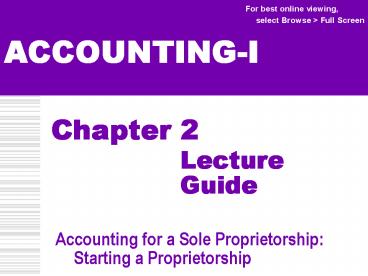Chapter 2 Lecture Guide PowerPoint PPT Presentation
1 / 12
Title: Chapter 2 Lecture Guide
1
ACCOUNTING-I
For best online viewing, select Browse gt Full
Screen
Chapter 2
Lecture Guide
Accounting for a Sole Proprietorship Starting a
Proprietorship
2
- I. THE BUSINESS
A. Service Actions performed for customers
for a fee. B. Proprietorship A business
owned by one person.
Concept Business Entity Financial information
(for the business) is recorded and reported
separately from the owners personal financial
information.
II. THE ACCOUNTING EQUATION
Assets Liabilities Owners Equity This is THE
LAW in accounting!
Analyze the Chart of Accounts (p 18)
3
III. HOW BUSINESS ACTIVITIES CHANGE THE
ACCOUNTING EQUATION
Concept Unit of Measurement Business
transactions are stated in numbers that have
common values. Obviously, in the US, dollars are
used.
REMEMBER Assets MUST Liabilities
Owners Equity after each transaction is
recorded.
4
A. Received Cash from the Owner as an
Investment (10,000)
Illustration 2-1 (p 22) Transaction 1
New Balances gt
Cash increases when money is
invested. Owners Equity increases when the
owner puts money into the business.
5
B. Paid Cash for Supplies (1,577)
Illustration 2-2 (p 23) Transaction 2
New Balances gt
Both Cash and Supplies are asset
accounts. Reduce cash because money was paid
out and increase the supplies account to show the
business now owns supplies.
6
C. Paid Cash for Insurance (1,200)
Illustration 2-3 (p 24) Transaction 3
New Balances gt
Both Cash and Prepaid Insurance are asset
accounts insurance is an asset when it is first
purchased. The effect is the same as in
transaction 2.
7
D. Bought Supplies On Account (2,720)
Illustration 2-4 (p 25) Transaction 4
New Balances gt
The business now owns more supplies. On
account means the amount was charged. Amounts
owed on charge accounts are liabilities
therefore liabilities increase.
8
E. Paid Cash On Account (1,360)
Illustration 2-5 (p 26) Transaction 5
New Balances gt
The cash balance decreases when cash is
paid. Payments on account reduce the
business liability because it now owes less
money.
9
Write answers to Audit Your Understanding
questions on page 26.
1. The total of the asset account balances on
the left side equals the total of the liability
and owners equity account balances on the right
side of the balance sheet. 2. Since at least
two accounts are affected in each transaction,
either (1) another asset must be decreased or (2)
an account on the right side (liability or
owners equity) must be increased. 3. A
transaction can (1) increase one asset account
while decreasing a different asset account. Two
transactions would be required to increase or
decrease a liability account while having the
same effect on the capital account more about
that later.
10
IV. REPORTING FINANCIAL INFORMATION ON A BALANCE
SHEET
Concept Going Concern Financial statements are
prepared with the expectation that the buisiness
will remain in operation indefinitely.
Current account balances are used to create a
balance sheet. The final balances shown below
(see 2-5) are used to create the balance sheet in
illustration 2-6 (p 27).
11
Write answers to Audit Your Understanding
questions on page 29.
1. Assets, Liabilities, and Owners
Equity 2. Assets 3. Liabilities Owners
Equity 4. (1) Check the amounts listed to be
sure they are the correct balances shown in the
ledger, the book which contains records of all
transactions entered in all accounts. (2) If
the correct balances were entered, work backward
checking calculations until the math error is
found. (3) Then appropriately change all
incorrect amounts which were posted as a result
of the error.
12
CREDITS
Based on Century 21 Accounting Ross, Hanson,
et al Southwestern Publishing Company, 1995
Restart Presentation
Esc to End

